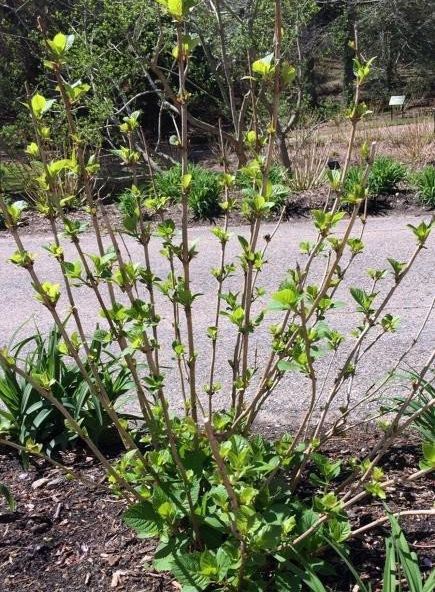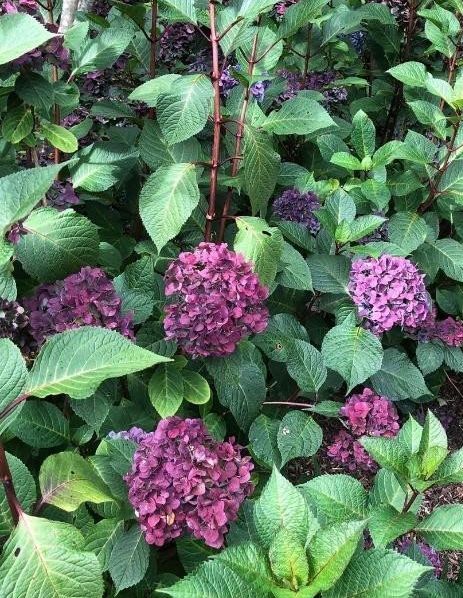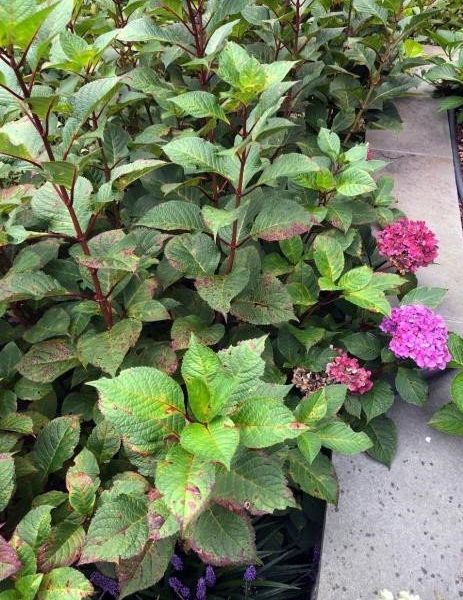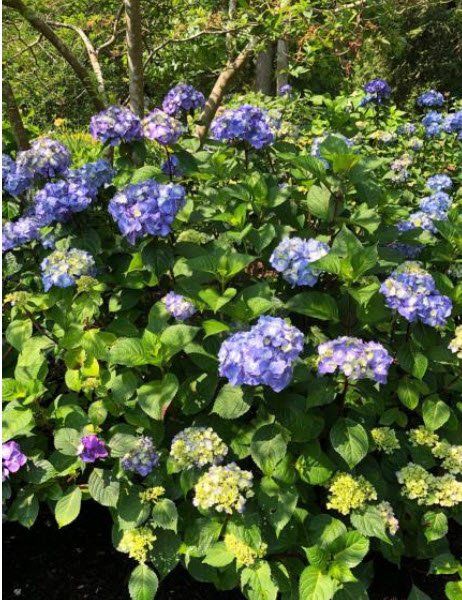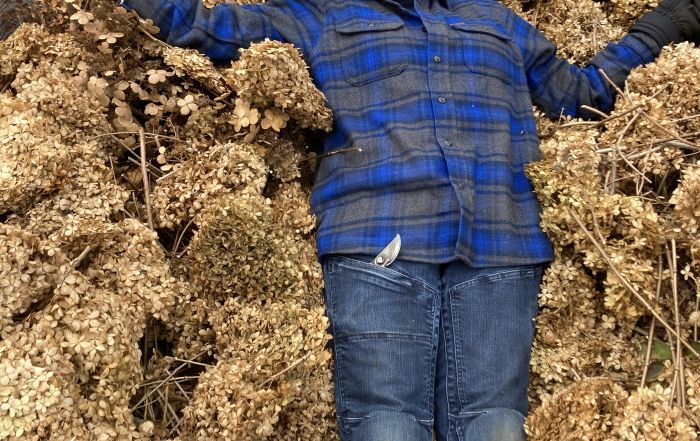Another introduction from Bailey Nurseries, BloomStruck™ is a more complex hybrid than the earlier Endless Summer Series of reblooming H. macrophylla and was developed to be exhibit substantially stronger bloom count that flowered well on both old and new wood. The bloom color is a very good vibrant blue that antiques to a rich dark purple in shaded locations. Bloom density is substantial as shown below during peak summer blooming at Heritage.


Winter Hardiness – Plant & Bud
Genetically, BloomStruck™ is an interspecific cross created to provide better bud cold-hardiness for mid-summer flowering on old wood and to also produce late season blossoms on new stem growth. And this cultivar does succeed on both counts, particularly from winter surviving stem buds as shown in the photo sequence below.
BloomStruck™ is the most free-flowering of the (5) cultivars in the Endless Summer Series at Heritage; the mophead blossoms have attractive medium to deep purple blue colors as can be observed in the photo on the above right.
Like all the H. macrophyllas at Heritage, the BloomStruck™ plantings are pruned annually in April-May and receive well automated surface (drip) irrigation. The majority of the plants went in the ground in 2014 with some relocations in 2016 when the Test Garden was established. One group of these 2016 plants went into quite sunny locations and quickly developed Cercospera leaf-spotting. In early autumn 2017 we moved these affected plants to two shaded locations and leaf spotting in 2018 was greatly reduced. This positive effect on leaf-spotting response was also observed in 2019.
Bloom Count & Quality
Flower development has been very good despite the vagaries of our weather – severe winter ‘snaps’ followed by an extended and chilly spring. Mid-summer flowering on BloomStruck™ old wood is strong with per plant bloom counts often exceeding (50). The only downside is the blooms are somewhat small – 3” to maybe 5”. Bloom color, owing to our adequate soil aluminum and low pH, produces the aforementioned attractive blue-purple tones.
Reblooming Capability
BloomStruck™ does rebloom reliably but somewhat modestly unless encouraged by mid-summer pinch-pruning. In our location, late July pinching of non-flowering stems – and spent blossoms – appears to ‘trigger’ the production of new growth with tip buds having a high potential for developing an inflorescence by early autumn. Timing is critical and we will continue to conduct our pinching trials to further optimize this reblooming.
General Growth Characteristics
Overall growth of our BloomStruck™ has been very good in terms of plant form, average stem density and uniformity of branching. It is a medium size plant for us, nominally 4 ft high and wide and quite similar to Endless Summer – Original™. Growth is vigorous and plant form responds favorably following judicious pruning. A single low-volume application of a granular controlled release fertilizer is applied in early spring and all plantings receive drip – surface irrigation.
Sun Tolerance
Given the already mentioned comments about sun exposure and Cercospera leaf spotting, our relocated BloomStruck™ are doing much better in the more shaded sites. One of our larger plantings is receiving highly diffused full-day sunlight and foliage there is totally clean.
Foliage Condition
Previous comments on leaf spotting is consistent with BloomStruck™. The plant does lose its leaves somewhat earlier than most of the H. macrophylla cultivars at Heritage. The photos below illustrate the leaf spotting associated with sun exposure.
Do note the ‘clean’ appearance of the plant on the above right. Even a modest reduction in direct sun exposure / intensity eliminates much of the Cercospera leaf spotting.
Disease & Pest Attack
Chilli Thrips are a concern as previously discussed, but their presence on BloomStruck™ to date has not been detected.
Looking Ahead
Pruning potentially offers additional benefits to reblooming cultivars. Early work with mid-summer (July) pinching of non-flowering stems showed an increase in late-season bloom development. This is a cultivar-specific issue; not all respond in a similar fashion. in 2020, we will be conducting further time-sensitive pruning trials on BloomStruck™to more fully evaluate the potential flowering benefit.
emc 191114, 191202, 200212
Recent Garden News & Blogs
Welcome Center Capital Campaign
Welcome Center Capital Campaign Announcement, July 12, 2023 Heritage Museums & Gardens Announces Capital Campaign for New Welcome Center July 12, 2023 (Sandwich, MA) Heritage Museums & Gardens, a beloved cultural institution known [...]
Volunteer Spotlight!
Volunteer Spotlight: Featuring Elliot Friend By: Iris Clearwater, Volunteer Coordinator & Senior Gardener Upon entering the J.K. Lilly Automobile Gallery, you cannot help but marvel at how perfectly clean and well maintained the cars [...]
Where Have All the Flowers Gone? And Yet Another Chapter
Where Have All the Flowers Gone – and Yet Another Chapter in 2023 Mal’s Corner – CCHS Spring 2023 Newsletter As most of you know, I do follow the weather patterns fairly closely and [...]
Volunteer Spotlight!
Volunteer Spotlight: Featuring Joy Bogstad By: Iris Clearwater, Senior Gardener Aptly named for the Joy she brings to everything that she does, and to all who have the pleasure to know her, Joy Bogstad [...]



